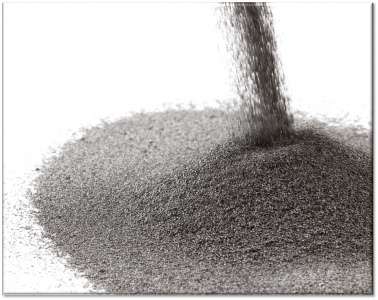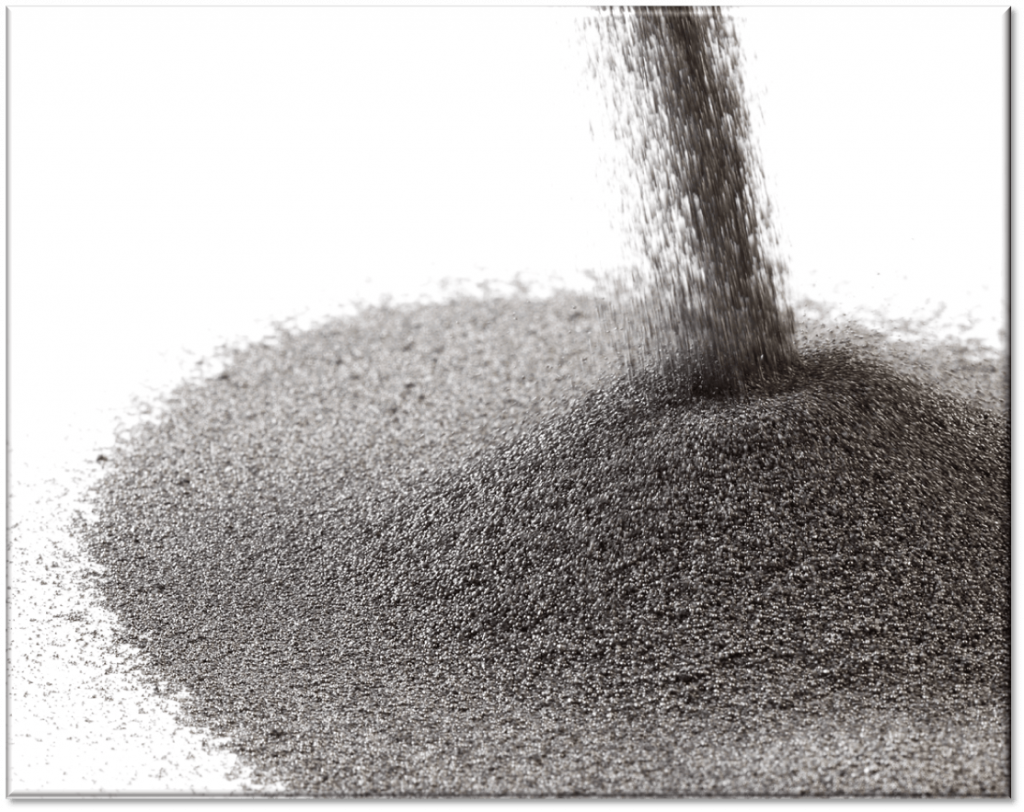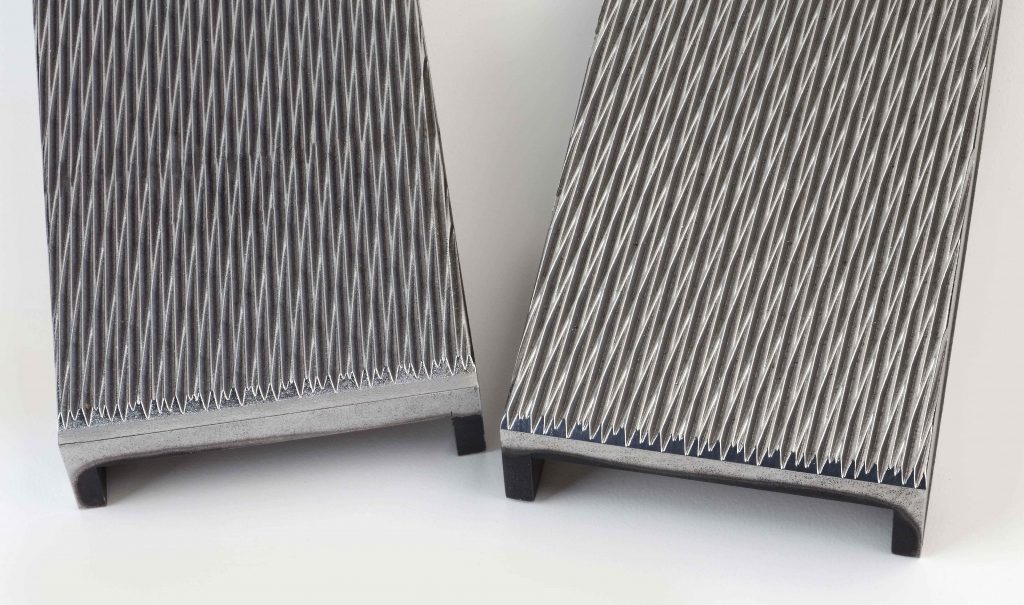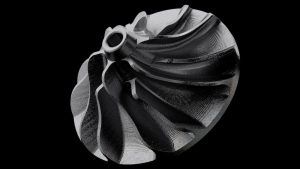Tooling Up for 3D-printable Steel

NanoSteel has created the BLDRmetal family of customized steel powders for additive manufacturing. The powders use a combination of conventional steel alloying elements to create a material sufficiently hard to print tooling and rugged components. (Image courtesy of NanoSteel.)
Latest News
August 1, 2017
As the cost of 3D printers comes down, more and more industries have begun to explore the potential of the technology, hoping to expand its application from prototyping to actual production roles. In the process, demand for more metal options has increased. Unfortunately, the number of metals and alloys that can be printed remains fairly limited.
Although the additive manufacturing market offers several metals suitable for production of complex parts — ranging from nickel alloys and aluminum to titanium — many simply do not offer the strength and reliability required for demanding applications. All these factors have ramped up pressure on technology providers to deliver the means to produce a broader array of 3D-printable steel.
The Trouble with Steel
To understand why steel poses such a challenge for 3D printing, you have to look at the production process on the microscopic level.“The microstructure of steels is more complex than nonferrous alloys,” says Professor Wei Xiong, a research scientist at the University of Pittsburgh’s Physical Metallurgy & Materials Design Laboratory. “We want to make sure that we can print steel with the same mechanical property as we do in subtractive processing. We design alloy microstructure because it is the key to control of the mechanical properties. Different processing parameters can lead to different microstructure. Therefore, producing desirable microstructure is the key to the printing process and post-heat treatment of the alloy after printing.”
These complex material-process interactions, in turn, call for greater control of the printing process.
“The impediments to developing 3D-printable steels depend on the printing process,” says Harald Lemke, vice president of engineered powders, NanoSteel. “In the powder bed fusion process, high cooling rate is a challenge because this causes many materials to crack. In binder jet and in fused deposition modeling, the main challenge is [performing] a complete sintering to make a fully dense (near 100%) part.”
The Beauty of Steel
But despite all the challenges that 3D-printable steel presents, market demand simply won’t take “no” for an answer. Too many top-value applications will benefit from the technology. For now, efforts to meet this demand focus on the development of materials and hardware capable of printing steel.Manufacturers are particularly keen to harness the power of tool steel because its hardness provides high tolerance for heat and abrasion. In addition, production facilities can choose from multiple grades of tool steel to support a variety of applications.
According to Lemke, “there are many applications, such as tooling, where the benefits of 3D printing are quite apparent because they are making small batches, face long lead times, and see advantage in being able to increase the intricacy of the design in ways not compatible with casting or machining. These applications are varied, and examples include tooling, such as dies or jigs, and components, such as valves or bearings.”
Potential users are looking for processes that reliably produce steel of the same quality as that manufactured by traditional processes. “The physical properties that are important in 3D-printable steel greatly depend on the application,” says Lemke. “These include hardness, strength, thermal conductivity, and fatigue resistance. Regardless of the end use property sets, the steels need to be reliably printable at or near room temperature without cracking, independent of part geometry.”
 NanoSteel has created the BLDRmetal family of customized steel powders for additive manufacturing. The powders use a combination of conventional steel alloying elements to create a material sufficiently hard to print tooling and rugged components. (Image courtesy of NanoSteel.)
NanoSteel has created the BLDRmetal family of customized steel powders for additive manufacturing. The powders use a combination of conventional steel alloying elements to create a material sufficiently hard to print tooling and rugged components. (Image courtesy of NanoSteel.)Enter Nano-structured Steel Powders
One of the companies that have advanced the cause of 3D-printable steel is NanoSteel. The Rhode Island-based firm has introduced BLDRmetal L-40, a case-hardening steel powder tailored for the laser powder bed fusion process.A printable steel powder, BLDRmetal L-40 features as-built hardness in excess of 40 HRC, which increases after heat treatment to over 50 HRC, while maintaining high ductility and toughness. In addition, case hardening can elevate the material’s surface hardness to 74 HRC without impacting the core properties, according to the company.
BLDRmetal L-40 has lower carbon content than typical tool steels. Therefore, the company says it doesn’t crack during the printing process, as is often the case with H13 tool steel. “BLDRmetal L-40 can be processed at typical printing temperatures [RT to 200 C] and has higher hardness and ductility than M300 maraging steel, the only other commonly printed tool steel,” says Lemke. “Most other tool steels are either not printable through this process at all or require elevated temperatures, nonstandard equipment, and restricted geometry.”
 NanoSteel’s BLDRmetal L-40 represents a new class of printable steel powders that promise both high hardness and toughness. (Image courtesy of NanoSteel.)
NanoSteel’s BLDRmetal L-40 represents a new class of printable steel powders that promise both high hardness and toughness. (Image courtesy of NanoSteel.)BLDRmetal L-40 is the first alloy in NanoSteel’s emerging powder bed fusion alloy portfolio. According to the company, BLDRmetal steel powders are printable on standard equipment, some are tailored for powder bed fusion (selective laser melting) 3D printers, and others for binder jet 3D printing.
 MarkForged’s Atomic Diffusion Additive Manufacturing powder enables engineers to print complex geometries like this impeller with corrosion-resistant 316L stainless steel, reducing production time and cost. (Image courtesy of MarkForged.)
MarkForged’s Atomic Diffusion Additive Manufacturing powder enables engineers to print complex geometries like this impeller with corrosion-resistant 316L stainless steel, reducing production time and cost. (Image courtesy of MarkForged.)Atomic Diffusion Additive Manufacturing
Another company advancing metal 3D printing technology, MarkForged has released its Atomic Diffusion Additive Manufacturing (ADAM), a metal 3D printing method that promises fast and accurate creation of tools and parts. ADAM uses metal powders encased in plastic binders, which dissolve after the printing process. Sintering then transforms the printed part into engineering metals, ranging from aluminum and titanium to stainless steel. The technology sinters the entire part at once, allowing metal crystals to pass through the bonded layers, maximizing strength and durability. The process can produce dense metal tools and parts suitable for a wide range of industries, including manufacturing, medical, and aerospace applications.This 3D printing method promises design engineers and manufacturers a number of advantages. “Workflows are simplified, and lead times are slashed compared with traditional means of creating metal parts,” says Jon Reilly, vice president of product for MarkForged. “Our technology also increases design flexibility, unlocking new geometries like captive infills, which could not be produced before.”
In the Works
Although these two commercial products represent important advances in metal 3D printing, academic research laboratories also pursue development in this area.The Office of Naval Research has awarded a $449,000 grant to the University of Pittsburgh’s Swanson School of Engineering to develop next-generation metals, especially steel. The work will focus on creating a high-strength, low-alloy steel for naval construction. Using integrated computational materials engineering tools, the researchers will engineer the composition of the materials, optimizing them for direct metal laser sintering. The scientists will also work on post-process optimization to enhance the materials’ mechanical properties and ability to resist corrosion.
This research promises to lay the groundwork for future metal 3D printing. “We need to explore new theory and methods for designing 3D-printable steels,” says Xiong. “This will further push the current alloy design capability.”
Subscribe to our FREE magazine, FREE email newsletters or both!
Latest News






